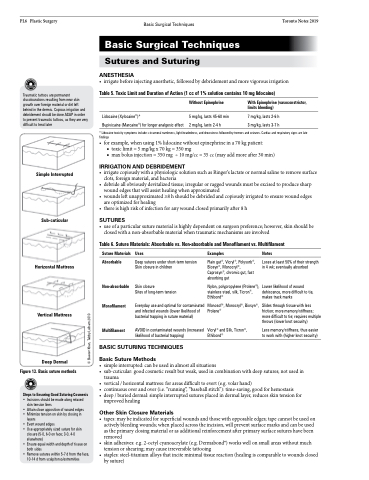Page 1128 - TNFlipTest
P. 1128
PL6 Plastic Surgery
Traumatic tattoos are permanent discolourations resulting from new skin growth over foreign material or dirt left behind in the dermis. Copious irrigation and debridement should be done ASAP in order to prevent traumatic tattoos, as they are very difficult to treat later
Simple Interrupted
Sub-cuticular
Horizontal Mattress
Vertical Mattress
Deep Dermal Figure 13. Basic suture methods
Steps to Ensuring Good Suturing Cosmesis
• Incisions should be made along relaxed skin tension lines
• Attain close apposition of wound edges
• Minimize tension on skin by closing in
layers
• Evert wound edges
• Use appropriately sized suture for skin
closure (5-0, 6-0 on face; 3-0, 4-0
elsewhere)
• Ensure equal width and depth of tissue on
both sides
• Remove sutures within 5-7 d from the face,
10-14 d from scalp/torso/extremities
Basic Surgical Techniques Toronto Notes 2019 Basic Surgical Techniques
Sutures and Suturing
ANESTHESIA
• irrigatebeforeinjectinganesthetic,followedbydebridementandmorevigorousirrigation
Table 5. Toxic Limit and Duration of Action (1 cc of 1% solution contains 10 mg lidocaine)
Lidocaine (Xylocaine®)*
Bupivicaine (Marcaine®) for longer analgesic effect
Without Epinephrine
5 mg/kg, lasts 45-60 min 2 mg/kg, lasts 2-4 h
With Epinephrine (vasoconstrictor, limits bleeding)
7 mg/kg, lasts 2-6 h 3 mg/kg, lasts 3-7 h
* Lidocaine toxicity symptoms include: circumoral numbness, light-headedness, and drowsiness followed by tremors and seizures. Cardiac and respiratory signs are late findings
• forexample,whenusing1%lidocainewithoutepinephrineina70kgpatient:
■ toxiclimit=5mg/kgx70kg=350mg
■ max bolus injection = 350 mg ÷ 10 mg/cc = 35 cc (may add more after 30 min)
IRRIGATION AND DEBRIDEMENT
• irrigatecopiouslywithaphysiologicsolutionsuchasRinger’slactateornormalsalinetoremovesurface clots, foreign material, and bacteria
• debrideallobviouslydevitalizedtissue;irregularorraggedwoundsmustbeexcisedtoproducesharp wound edges that will assist healing when approximated
• woundsleftunapproximated≥8hshouldbedebridedandcopiouslyirrigatedtoensurewoundedges are optimized for healing
• thereishighriskofinfectionforanywoundclosedprimarilyafter8h
SUTURES
• useofaparticularsuturematerialishighlydependentonsurgeonpreference;however,skinshouldbe closed with a non-absorbable material when traumatic mechanisms are involved
Table 6. Suture Materials: Absorbable vs. Non-absorbable and Monofilament vs. Multifilament
Suture Materials
Absorbable
Non-absorbable Monofilament
Multifilament
Uses
Deep sutures under short-term tension Skin closure in children
Skin closure
Sites of long-term tension
Everyday use and optimal for contaminated and infected wounds (lower likelihood of bacterial trapping in suture material)
AVOID in contaminated wounds (increased likelihood of bacterial trapping)
Examples
Plain gut®, Vicryl®, Polysorb®, Biosyn®, Monocryl®, Caprosyn®, chromic gut, fast absorbing gut
Nylon, polypropylene (Prolene®), stainless steel, silk, Ticron®, Ethibond®
Monosof®, Monocryl®, Biosyn®, Prolene®
Vicryl® and Silk, Ticron®, Ethibond®
Notes
Loses at least 50% of their strength in 4 wk; eventually absorbed
Lower likelihood of wound dehiscence, more difficult to tie, makes track marks
Slides through tissue with less friction; more memory/stiffness; more difficult to tie; requires multiple throws (lower knot security)
Less memory/stiffness, thus easier to work with (higher knot security)
BASIC SUTURING TECHNIQUES
Basic Suture Methods
• simpleinterrupted:canbeusedinalmostallsituations
• sub-cuticular: good cosmetic result but weak, used in combination with deep sutures; not used in
trauma
• vertical/horizontalmattress:forareasdifficulttoevert(e.g.volarhand)
• continuousoverandover(i.e.“running”,“baseballstitch”):time-saving,goodforhemostasis
• deep / buried dermal: simple interrupted sutures placed in dermal layer, reduces skin tension for
improved healing
Other Skin Closure Materials
• tapes:maybeindicatedforsuperficialwoundsandthosewithopposableedges;tapecannotbeusedon actively bleeding wounds; when placed across the incision, will prevent surface marks and can be used as the primary closing material or as additional reinforcement after primary surface sutures have been removed
• skinadhesives:e.g.2-octylcyanoacrylate(e.g.Dermabond®)workswellonsmallareaswithoutmuch tension or shearing; may cause irreversible tattooing
• staples:steel-titaniumalloysthatinciteminimaltissuereaction(healingiscomparabletowoundsclosed by suture)
© Baseer Khan, Tabby Lulham 2010


